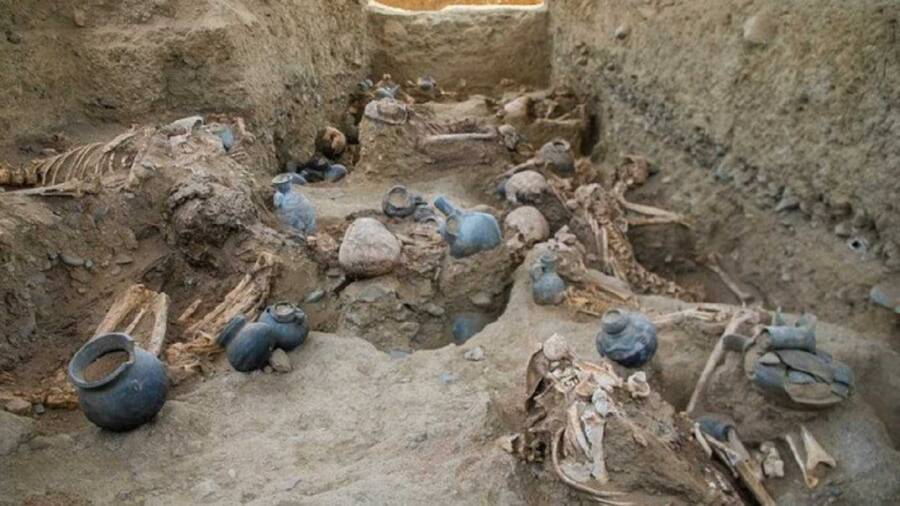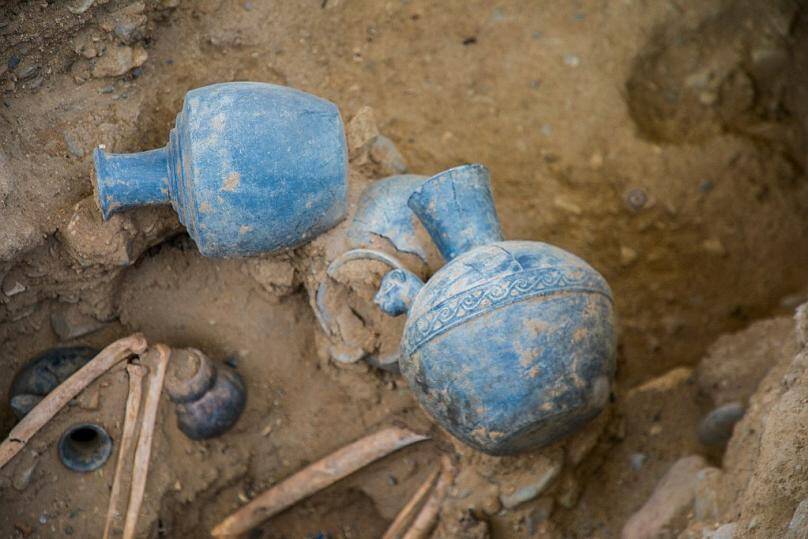Archeologists came across the remains of 25 women and children buried together but aren't yet sure how they died.

Peruvian Ministry of CultureArcheologists examine the remains, which were buried with ceramics and textile tools.
Chan Chan, meaning “resplendent sun,” once flourished as the capital of the Chimú Empire. Now, the discovery of a mass grave at the Chan Chan archeological site is shedding light on how this ancient culture dealt with death.
Archeologists with the Chan Chan Archaeological Complex Special Project uncovered the remains of 25 people, young women and children, at the Utzh An (Great Chimu) walled complex. This location, noted Jorge Meneses, an archaeologist at Trujillo National University who is leading the archeological project, makes the discovery “unusual.”
The skeletons are unusual, too. Each of the remains was carefully wrapped — first with cotton fabric and then with plant tissue — and buried in a seated position. Most are women under 30, alongside a number of teenagers and children.
“It is a very specific population,” remarked Meneses. “Not too young considering the average human lifespan was 40 years.”

Peruvian Ministry of CultureThe mass grave contains 25 skeletons, all under the age of 30.
The grave — sealed with mud that contained jar fragments — was also filled with a number of objects. Archeologists found metal needles, wooden spindles, chalk, and dozens of ceramics. They believe that the needles, spindles, and chalk indicate that the people buried in the grave were “dedicated” to textiles.
“Due to the disposition and posture of such deceased, one has the impression of a recreation of the activities that they carried out in life,” explained the Peruvian Ministry of Culture in a statement.
Though textile objects may suggest that the women were working-class, archeologists suspect that their manner of burial and the location of the grave instead signals that they were part of Chan Chan’s “elite” society.
In addition, Meneses said, the grave appears to contain both older and new skeletons. Some of them seem to have been buried shortly after death; others have bleached bones and are buried in a jumble, suggesting they were added to the grave later.
“This shows that the Chimús used to relocate and manipulate their deceased,” explained Sinthya Cueva García, director of the Archaeological Research Program of the Chan Chan Archaeological Complex Special Project.

Peruvian Ministry of CultureSome of the ceramics found in the Chan Chan mass grave.
Though the mass grave found recently in Chan Chan is astonishing, it’s hardly the first — or largest — that archeologists discovered in the area.
In 2011, archeologists discovered the shocking, sprawling burial ground called Huanchaquito-Las Llamas. There, they uncovered the remains of 140 children between the ages of 5 and 14 as well as 200 llamas. Both the children and the animals, they believe, were killed in one of the largest known child sacrifices in human history.
So far, archeologists don’t think that the newest mass grave found at Chan Chan was the result of human sacrifice. But it does offer a glimpse at life in the Chimú Empire.
This vast and powerful empire, which controlled Peru’s northern coast from about 850 A.D. to 1470 A.D., once stood as a beacon of society and industry. Chan Chan, Chimú’s capital city, was the empire’s crown jewel.
Here, between 40,000 and 60,000 people once went about their daily lives. They navigated a labyrinth of thousands of adobe structures, visited temples, and enjoyed great wealth. Though Chan Chan was built in the desert, the Chimú Empire constructed an intricate irrigation canal to ensure that agriculture could flourish.

Wikimedia CommonsIntricate carvings at the Chan Chan ruins.
But Chan Chan — and the Chimú Empire — fell in about 1470. Then, the Incans swept in and conquered the city, irrevocably fracturing the Chimú hold on power. Less than 100 years later, Spanish conquistadors arrived and took whatever gold and silver they could find.
As such, Chan Chan today is a mere echo of former might. But discoveries like the mass grave of women and children can offer an elusive peek at how people in Chan Chan lived, died, and thought about death and remembrance.
Archeologists hope to continue their excavation. As they search the site, they’ll look for more clues about this fascinating pre-Hispanic culture.
After reading about the mass grave discovered at Chan Chan in Peru, learn about the mass grave at the Odessa airport which may be Ukraine’s largest ever found. Or, discover the story of the mass grave in Timisoara, Romania linked to the plague.





